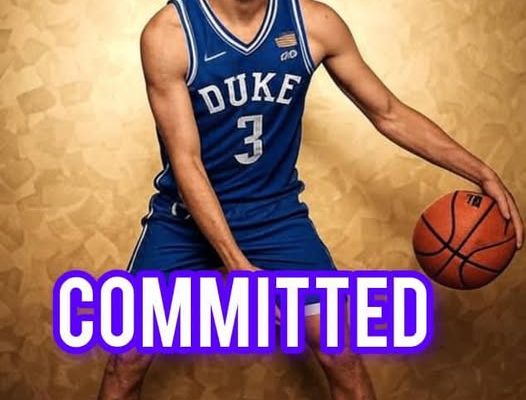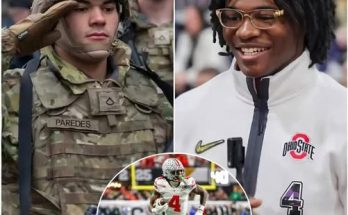The college basketball world thrives on unpredictability, and nothing captures the imagination of fans and analysts alike more than the decisions of top recruits who hold the power to reshape the balance of power in the sport with a single commitment. That dynamic came alive once again when the nation’s No. 1 basketball recruit stunned the college basketball community by committing to Duke University, choosing the storied program over powerhouse competitors Tennessee and Florida. In an era where recruiting wars have become as heated and closely followed as the games themselves, this decision sent ripples throughout the sport and immediately elevated Duke’s already impressive recruiting class into one of the nation’s most talked about.
Duke has long been a symbol of excellence in college basketball, synonymous with the name of legendary coach Mike Krzyzewski and the dynasties he built over decades. Since his retirement, however, there has been a consistent narrative questioning whether the Blue Devils could maintain that same level of dominance under Jon Scheyer, a younger coach still carving out his identity in the cutthroat world of college basketball recruiting. For all the early success and flashes of promise, questions remained about whether Scheyer could go toe-to-toe with rival coaches who have developed reputations as recruiting juggernauts in their own right. This commitment from the No. 1 recruit, however, delivers an emphatic answer and underscores Duke’s staying power as one of the premier destinations for elite talent.
What makes this decision so captivating is not simply that Duke landed the best player in the country, but that the Blue Devils did so while beating out Tennessee and Florida, two programs that have surged in recent years and shown they are capable of going after the same type of elite talent Duke once seemed to attract almost automatically. Tennessee, under Rick Barnes, has emerged as one of the most consistent programs in the SEC, capable of developing NBA-ready players while competing deep into March. Florida, on the other hand, continues to lean on its storied history from the Billy Donovan era while trying to re-establish itself as a championship contender. Both schools pulled out all the stops in their recruitment pitches, offering not only playing time and development opportunities but also strong NIL packages in a modern landscape where athletes’ brand value is as critical as their on-court production. To see both programs come up short in this battle illustrates just how far Duke’s recruiting machine extends, even against competitors with growing momentum.
The No. 1 recruit in the nation is more than just a highly skilled basketball player; he is the kind of generational talent who draws comparisons to the elite names that came before him. Scouts describe him as a versatile forward with NBA-level athleticism, the ability to create his own shot, and the defensive versatility to guard multiple positions. The buzz surrounding his potential has been compared to some of the greats who have come through the college ranks in recent years, making his choice of Duke that much more impactful. Programs don’t just view recruits like him as players—they view them as potential program-changers, capable of drawing other top recruits into their orbit, galvanizing fanbases, and elevating a program’s ceiling from good to elite.
For Duke, this is a momentum-shifting win. While the Blue Devils have consistently attracted high-level talent, the perception of dominance in recruiting had, at times, felt slightly diminished with other programs increasingly winning their share of battles. Kentucky has long been viewed as a rival for one-and-done talent. Programs like Kansas, North Carolina, and even newer faces like Gonzaga have found ways to insert themselves into the conversations for the nation’s best players. But with this commitment, Duke plants its flag firmly once again, reminding the basketball world that when it comes to securing elite talent, the Blue Devils are still in rarefied air.
There is also the domino effect to consider. One major recruit often opens the door for others to follow, and the ripple effect of this decision could define Duke’s recruiting class for years to come. Top recruits often pay attention to who else is committing to certain programs, with players seeking to join forces with peers who can help them compete for championships and increase their exposure. With the No. 1 recruit now committed, it becomes significantly easier for Duke’s staff to convince other high-profile recruits that Durham is the place to be. Already, there is speculation that other five-star players are taking a renewed look at Duke, knowing they would have the opportunity to play alongside such a game-changing talent. This is not just about one player—it is about building a foundation for a potential national championship run.
The landscape of college basketball is in constant flux, especially with the introduction of NIL opportunities that have dramatically changed recruiting. Tennessee and Florida reportedly made strong cases in that regard, presenting lucrative and appealing packages designed to give the recruit not just a college basketball experience but also significant financial benefits. Yet Duke, with its combination of tradition, exposure, and recent adaptation to the NIL era, presented a pitch that ultimately proved too strong to pass up. The Blue Devils have increasingly shown they are capable of competing in the new era while also leveraging their longstanding reputation as a pipeline to the NBA. That dual appeal—success now and preparation for the professional ranks—gives Duke a unique advantage that continues to resonate with recruits and their families.
The reaction across the college basketball world has been swift and intense. Analysts immediately began discussing what this means for the balance of power in the ACC and nationally. Tennessee and Florida fans expressed disappointment at coming so close, with some acknowledging that Duke’s pull remains unmatched for certain types of players. Meanwhile, Duke fans celebrated the news with enthusiasm, viewing this as both a validation of Scheyer’s recruiting abilities and as a signal that the Blue Devils remain at the forefront of college basketball’s elite. For rivals like North Carolina, Kentucky, and Kansas, this commitment serves as a reminder that the recruiting wars remain as competitive as ever, and that beating Duke for a top recruit will always be a daunting task.
It is also worth noting how this decision will impact the on-court product once the recruit arrives at Duke. With his combination of size, athleticism, and skill, he projects to step in as an immediate contributor, likely becoming the focal point of the Blue Devils’ offense from day one. His ability to handle the ball, score at all three levels, and defend across positions provides a level of versatility that modern basketball thrives on. In a college game increasingly shaped by pace, spacing, and switchable defenders, he fits the mold perfectly. For Duke, the presence of such a player not only elevates their ceiling but also gives them a legitimate chance at national title contention, depending on the pieces they can surround him with.
Beyond the immediate basketball implications, this commitment also reflects the enduring power of brand identity in college sports. Duke, despite no longer being led by Coach K, continues to carry a level of prestige that resonates with recruits. The culture built over decades, the visibility of playing in Cameron Indoor Stadium, and the legacy of NBA stars who came through the program are all elements that contributed to this decision. For Tennessee and Florida, the challenge now becomes finding ways to not only compete on the court but also to continue to chip away at that brand dominance in recruiting battles. Losing the No. 1 recruit stings, but both programs remain strong and will undoubtedly be back in contention for other top players.
What this moment underscores is that in the ever-changing landscape of college basketball, some things remain constant. Recruits may weigh NIL offers, playing time, coaching relationships, and program trajectories, but tradition and proven pathways to the next level still hold enormous value. Duke’s ability to secure this commitment demonstrates their mastery of blending the old and the new, combining their storied past with modern adaptability. For the rest of college basketball, the message is clear: the Blue Devils are not going anywhere.
In the end, this decision is bigger than just one player picking one school. It is about how a single recruit’s choice can alter narratives, shift momentum, and redefine expectations for entire programs. Duke’s acquisition of the No. 1 recruit has instantly elevated their recruiting class, reinvigorated their fanbase, and reminded the sport that the Blue Devils remain one of the ultimate destinations for elite basketball talent. As the young star prepares to don the blue and white, the college basketball world waits eagerly to see how his presence will shape the future of Duke basketball and, by extension, the broader national landscape. This is the kind of decision that will be remembered not just during his college career but long after, as one of those turning points that define an era.
This is the shockwave that makes college basketball recruiting so thrilling, and this commitment will be talked about for months to come, not only because of the player’s undeniable talent but also because of what it signals for Duke’s continued dominance in the sport. One recruit can change everything, and in this case, he just did.



